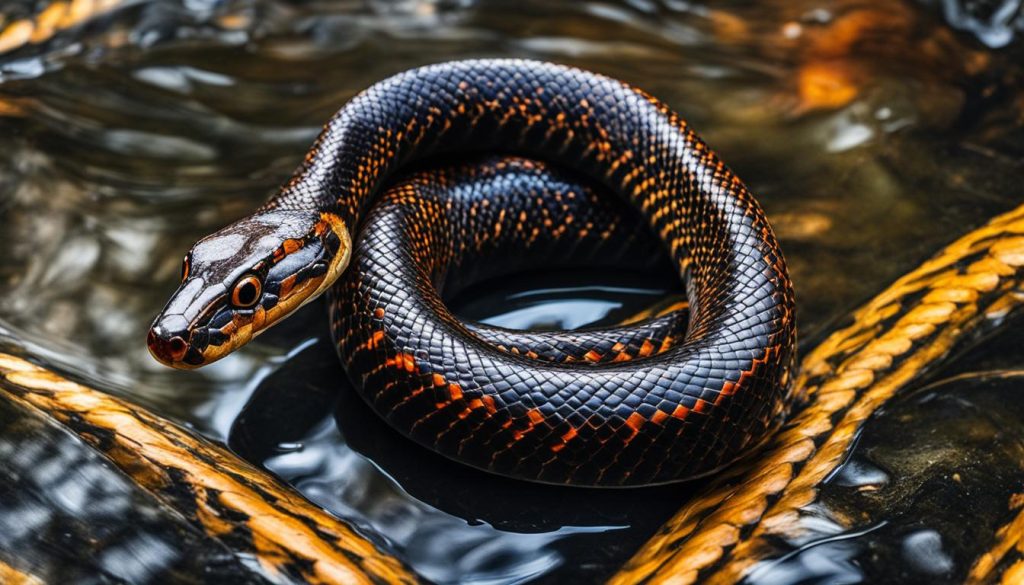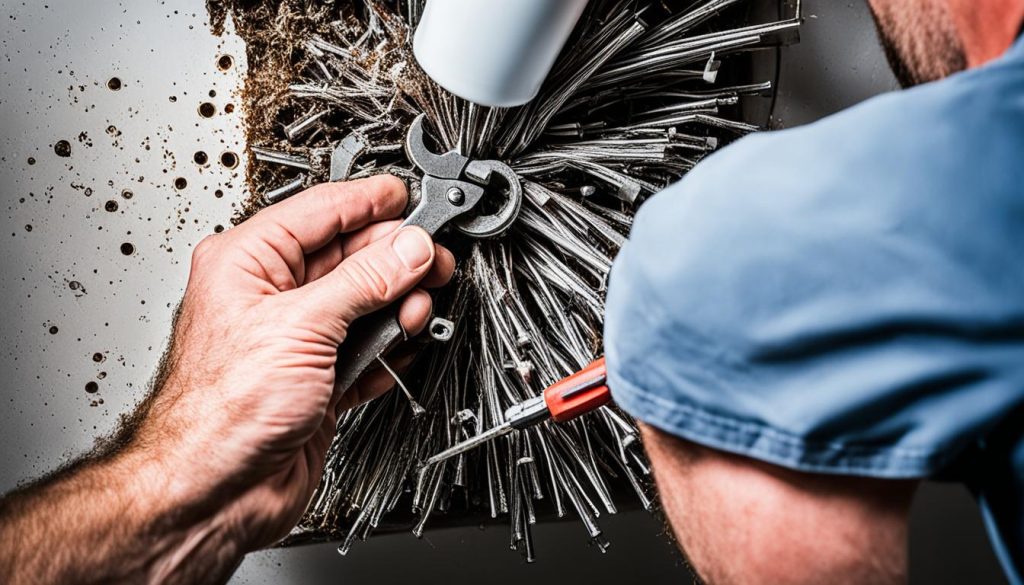Clear Clogged Drains: Remove Hair Easily
If there’s one type of clog almost everybody deals with at some point, it’s a hair clog. Did you know that hair can accumulate in your drains over time and create nasty clumps that drastically slow down your drains? It’s a common problem that can cause frustration and inconvenience. But fear not, because I’m here to share with you five simple ways to get rid of those gross hair blockages and help your drains flow freely once again.
Key Takeaways:
- Use baking soda and vinegar to dissolve and loosen hair clogs before plunging them out.
- Pull out hair with tweezers or needle-nose pliers if it’s difficult to plunge.
- Try using a drain snake to break apart stubborn hair clogs.
- Remove your whole drain as a last resort if other methods fail.
- Prevent future hair clogs by brushing hair before showering and using drain protectors.
Use Baking Soda & Vinegar on the Hair Clog Before Plunging It Out
Baking soda and vinegar can be an extremely effective way of dispatching many clogs, and hair clogs are no exception. For best results, start by squirting a little dish soap into your drain, followed by a cup of vinegar and a cup of baking soda. Wait five minutes or so, for the chemical reaction of the vinegar and baking soda to take effect, then chase that with a cup or more of boiling water.
This should effectively clear out most of the hair clog, however, you should still use a cup plunger on your drain to get rid of any hair that is left behind. Make sure you are using a cup or “flat” plunger specifically, and if the clog is still present, repeat this process as necessary.
Step-by-step Guide: Using Baking Soda & Vinegar to Clear Hair Clogs
- Squirt a little dish soap into the drain.
- Pour a cup of vinegar into the drain.
- Add a cup of baking soda into the drain.
- Wait for five minutes to allow the chemical reaction to occur.
- Pour a cup or more of boiling water into the drain.
- Use a cup plunger on the drain to remove any remaining hair.
- If the clog persists, repeat the process.
The combination of baking soda and vinegar creates a foaming action that helps to dissolve hair clogs and break them apart. The boiling water helps to flush out the loosened hair, while the cup plunger is effective in dislodging any stubborn bits. This DIY method is a cost-effective and eco-friendly solution to tackle hair clogs in your drains.
| Baking Soda & Vinegar Method | Advantages |
|---|---|
| Safe, non-toxic ingredients | Gentle on pipes |
| Environmentally friendly | Easy and affordable |
| No harsh chemicals | Effective for hair clogs |
Using baking soda and vinegar is a tried and true method for clearing hair clogs in drains. Not only is it safe for your pipes and the environment, but it’s also an affordable solution that utilizes common household ingredients. Give this method a try before reaching for harsh chemical drain cleaners, and you’ll be amazed at how well it works!
Pull the Hair Out of the Drain with Tweezers or Needle-Nose Pliers
Unlike thicker clogs, the stringy nature of hair can sometimes make it difficult to plunge out. If you have tried to remove a hairy obstruction by plunging it out of your drain but just can’t quite get rid of it, you may need to try pulling it out with a pair of tweezers instead.
First, you’ll need to take off your drain stopper if you have one. In some cases, you may need to do this manually, though you may also need a screwdriver, depending on the nature of your drain.
After that, take a flashlight and shine it into your drain so you can get a better look at the blockage in question. From there, you should be able to use your needle-nose pliers to pull out that unpleasant accumulation of hair.
You may want to wear gloves as you go about this process, as pulling hair out can get pretty nasty, and you should also run some hot water down your drain after you finish, just to flush any nascent hairs out.
Purchase a Drain Snake
If melting your hair clog with baking soda and vinegar, plunging it out, and using tweezers to remove it still hasn’t done the trick, you may be able to break that clog apart with a snaking device. What kind of snake you ask? Any number of options may do, depending on the severity of your clog. For less severe cases, straightening out a wire hanger and sticking that down your drain to break up a clog can actually do the trick. Other times, you may want to buy a zip-it tool. These plastic drain cleaners are cheap, disposable and easy-to-use, and widely available online. There are also a number of other drain snake devices you can purchase at your local hardware store or online, all designed to deal with varying sizes of clogs. Snaking your drain should effectively break up any clogs and help scrape the walls of your line clean, but you may also want to follow up with the baking soda and vinegar technique outlined above or at least flush your drain out with hot water, just to be sure the clog is completely gone.
| Drain Snake Type | Description |
|---|---|
| Wire Hanger | Straighten out a wire hanger and use it to break up clogs in less severe cases. It’s a quick and inexpensive solution. |
| Zip-It Tool | Disposable plastic drain cleaner that is easy to use. It effectively removes hair clogs and is widely available online. |
| Other Drain Snake Devices | Various drain snake devices designed for different sizes of clogs. These can be purchased at your local hardware store or online. |
Remove Your Whole Drain
If a clog still persists after you’ve tried all the methods mentioned above, you can remove your drain entirely and try to clean it out that way. This method is the most intensive but can be effective in resolving stubborn hair clogs.
Removing a Sink Drain
If you’re dealing with a clogged sink drain, you’ll need to unscrew the p-trap, which is the p-shaped drain pipe located underneath the sink. Here’s how you can do it:
- Place a bucket beneath the p-trap to catch any water that may come dripping out.
- Using a wrench or pliers, unscrew the nuts on both ends of the p-trap.
- Once the nuts are loose, carefully remove the p-trap from the drain pipe.
Now that the p-trap is removed, you can clean out any hair or debris that may be causing the clog. Remember to wear rubber gloves for hygiene purposes.
Removing a Shower/Tub Drain
If your hair clog is in the shower or tub drain, you’ll need a plug wrench to remove the drain. Here’s how you can do it:
- Locate the crossbars of the drain, which are typically located beneath the drain cover.
- Insert the plug wrench into the crossbars and turn counterclockwise to loosen the drain.
- Continue turning until the drain can be easily lifted out of the drain pipe.
Once the drain is removed, you can clean it thoroughly to remove any accumulated hair and debris. Don’t forget to wear rubber gloves for protection.
If removing the drain seems too complicated or you’re not comfortable doing it yourself, consider calling a professional drain cleaning service. They have the expertise and proper tools to handle the job effectively.
| Pros | Cons |
|---|---|
| Allows for thorough cleaning of the drain | May require professional assistance |
| Effective in eliminating stubborn hair clogs | Can be a time-consuming and messy process |
| Addresses underlying issues in the drain system | May involve additional costs for professional services |
Ways to Prevent Hair from Clogging Drains in the Future
Now that you’ve successfully removed the hair clog from your drain, it’s important to take preventative measures to avoid future clogs. Fortunately, keeping hair out of your drains is easier than you might think. With a little preparation, you can drastically reduce the amount of hair that ends up causing blockages. Follow these effective tips to keep your drains flowing freely:
1. Brush your hair before showering: By brushing your hair before you get in the shower, you can minimize the amount of loose strands that end up going down the drain.
2. Install a shower drain hair trap: Consider purchasing a shower drain hair trap that fits securely over the drain. This will catch any hair before it has a chance to enter the drain line.
3. Maintain your drains: Keep your drains clean and prevent hair clogs by regularly pouring a mixture of white vinegar and baking soda down the drain. This combination helps dissolve grime and keeps your drains clear.
4. Try using a fabric softener sheet: Place a fabric softener sheet directly on top of the drain opening to trap hair while still allowing water to flow through. This simple trick can help prevent hair from accumulating in your drains.
5. Invest in a TubShroom drain protector: Consider purchasing a TubShroom drain protector, a revolutionary hair catcher designed to fit inside your drain. This innovative device catches both pet and human hair without interfering with water flow, keeping your drains free from clogs.
By following these preventive measures, you can maintain clean and clear drains, preventing hair clogs in the future. Incorporate these tips into your routine and say goodbye to the hassle of unclogging drains!
- Investing Wisely: How Windows & Doors in Boost Property Value and Financial Health - April 24, 2025
- The Financial Impact of Personal Injuries: Why Legal Help Matters for Business Owners - April 16, 2025
- The Hidden Financial Costs of Domestic Assault: What Business Owners Need to Know - April 16, 2025














